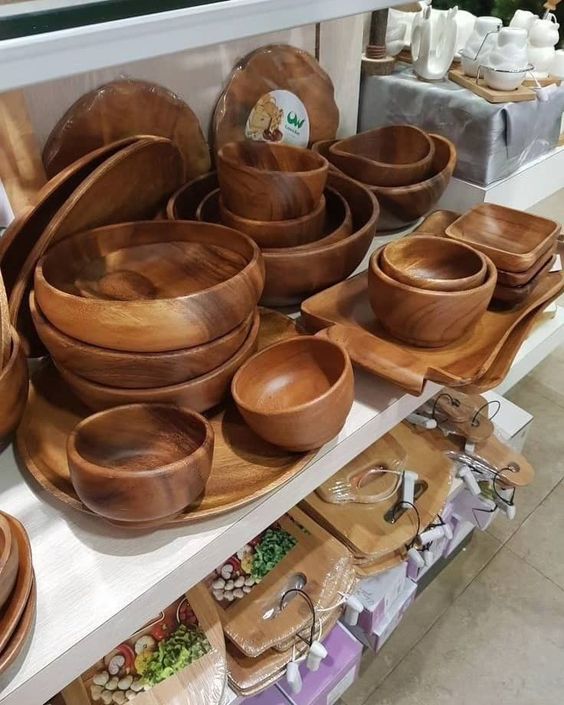Cutting boards are a kitchen essential, serving multiple functions, from prepping food to presenting it. For wood lovers, wooden cutting boards stand out for their durability, beauty, and natural antibacterial properties. Among the variety of wooden boards available, groove cutting boards offer unique advantages that make them particularly useful in certain kitchen tasks. In this blog post, we’ll dive into the different uses and benefits of cutting boards, and specifically compare groove wooden cutting boards to other wooden options, including their versatility as charcuterie and serving boards.
Why Wooden Cutting Boards?
Wooden cutting boards have long been a favorite in kitchens around the world, and for good reason. Here’s why they’re so popular:
-
Durability: Wooden boards, especially those made from hardwoods like acacia or maple, are tough enough to withstand daily chopping, slicing, and dicing. They resist warping and last for years with proper care.
-
Knife-Friendly Surface: Unlike glass or stone cutting boards, wood is gentle on knives, keeping your blades sharper for longer.
-
Antibacterial Properties: Wood has natural antibacterial properties, making it a hygienic choice for cutting raw meats, fruits, and vegetables.
-
Aesthetic Appeal: Wooden cutting boards bring a rustic, natural beauty to your kitchen, doubling as décor when not in use. They are also perfect for food presentation, adding a warm, earthy touch to any meal setting.
-
Eco-Friendly: Being a renewable resource, wood is a more sustainable option compared to plastic, making it a great choice for environmentally-conscious cooks.
Groove Cutting Boards: What Sets Them Apart?
Groove cutting boards, sometimes called juice groove boards, feature a recessed groove around the edges. This simple design feature adds a surprising level of practicality to the cutting board, particularly when handling juicy foods like meats, fruits, and vegetables.

Benefits of Groove Cutting Boards:
-
Juice Catcher: The most significant advantage of a groove cutting board is that it catches liquids. Whether you’re slicing a juicy watermelon or carving a roast, the groove prevents juices from spilling onto your countertop. This helps maintain cleanliness while cooking and makes clean-up easier.
-
Versatility in Use: Groove cutting boards are perfect for preparing raw meats, as the grooves collect any drippings. This feature is especially useful for barbecuing or roasting, where keeping your workspace clean and safe from cross-contamination is key.
-
Charcuterie and Serving Boards: Groove cutting boards can also double as charcuterie or serving boards. The grooves can hold dips, sauces, or even small garnishes around the edges, keeping your presentation neat and visually appealing.
-
Keeps Ingredients in Place: If you’ve ever chopped vegetables or meats that tend to roll off the board, you’ll appreciate how the groove helps prevent ingredients from sliding off.
Cons:
- Aesthetics: Some people prefer the smooth, uninterrupted look of a flat cutting board, especially when using it for serving. A groove may take away from the seamless look.
- Cleaning: While groove boards keep your counter cleaner, the grooves themselves can sometimes collect food particles and may require more detailed cleaning.
Regular Wooden Cutting Boards: Simplicity & Style
While groove cutting boards offer extra functionality, flat wooden cutting boards are equally popular for their simplicity and wide range of uses. These boards tend to have larger uninterrupted surfaces, making them ideal for cutting large items like loaves of bread or for presenting a clean, elegant look when used as serving or charcuterie boards.

Benefits of Flat Wooden Cutting Boards:
-
Multi-Purpose Functionality: Regular wooden cutting boards are incredibly versatile, allowing you to chop, slice, and serve without the need for specialized designs. They are ideal for cutting everything from vegetables to cheeses and bread.
-
Sleek Presentation: Smooth wooden boards can easily be repurposed as charcuterie boards. Their natural grain and finish make them a beautiful backdrop for cheeses, meats, fruits, and more. The clean design enhances the aesthetics of your food presentation, offering a minimalist yet rustic feel.
-
Ease of Cleaning: Without grooves, flat cutting boards are generally easier to clean. The uninterrupted surface can be wiped down quickly, making them a practical choice for everyday use.
Cons:
-
Messy Liquid Handling: The lack of grooves means any liquid from the food you’re preparing (such as meat drippings or fruit juices) can spill over the edge of the board and onto your countertop.
-
Less Versatile for Juicy Foods: When it comes to tasks that involve juicy or messy ingredients, a flat board might not be as practical as a groove cutting board.
Groove vs. Regular Wooden Cutting Boards: Which Should You Choose?
Choosing between a groove cutting board and a regular wooden board depends largely on your cooking habits and how you plan to use the board.
-
For Everyday Cooking: If you frequently prepare juicy meats or fruits, a groove cutting board is a great choice. It offers practical benefits for handling liquids and keeping your countertop clean.
-
For Presentation and Serving: If your primary goal is to serve food beautifully, a regular wooden cutting board without grooves might be more suitable. Its smooth, uninterrupted surface allows for a clean and polished presentation.
-
For Charcuterie: Both types of cutting boards can function as charcuterie boards. Groove cutting boards are great if you’re serving dips or sauces alongside your charcuterie items, as the grooves help keep everything in place. Flat wooden boards, on the other hand, offer a more streamlined, elegant look for showcasing cheeses, fruits, and meats.
Using Wooden Cutting Boards as Charcuterie, Cheese, and Serving Boards
Charcuterie boards, and Cheese Boards are a growing trend in home entertaining, and wooden cutting boards make for perfect charcuterie trays. Their sturdy build and natural texture create a visually appealing base for displaying an array of meats, cheeses, fruits, and crackers. Both groove and flat cutting boards have their place in charcuterie presentations:
-
Groove Cutting Boards: These boards are perfect for holding dips, sauces, and small items. The grooves act as a barrier to keep liquids or loose food items contained, ensuring a tidy presentation.
-
Flat Wooden Cutting Boards: Ideal for a classic charcuterie display, these boards offer a clean and spacious area to arrange food. Their minimalist look emphasizes the vibrant colors and textures of your charcuterie spread.
Beyond charcuterie, wooden cutting boards can also serve as beautiful serving platters for breads, desserts, or appetizers. Their durability makes them practical for cutting, while their aesthetic appeal makes them perfect for serving.
Final Thoughts: Which Wooden Cutting Board is Right for You?
In the end, the choice between a groove cutting board and a regular wooden cutting board comes down to your cooking and entertaining needs. If you often deal with juicy ingredients and prefer added functionality, a groove cutting board is an excellent choice. However, if you prioritize sleek, minimalistic presentations or want a versatile cutting surface for general use, a regular wooden cutting board might be more up your alley.
Both types of boards offer excellent durability, beauty, and versatility, making them essential kitchen tools for any wood lover. Whether you’re chopping, serving, or displaying charcuterie, wooden cutting boards bring a natural, timeless elegance to your kitchen and dining experience.
With this guide, you can confidently choose the best cutting board for your needs, whether for practical everyday use or for serving up a stunning charcuterie board at your next gathering!


